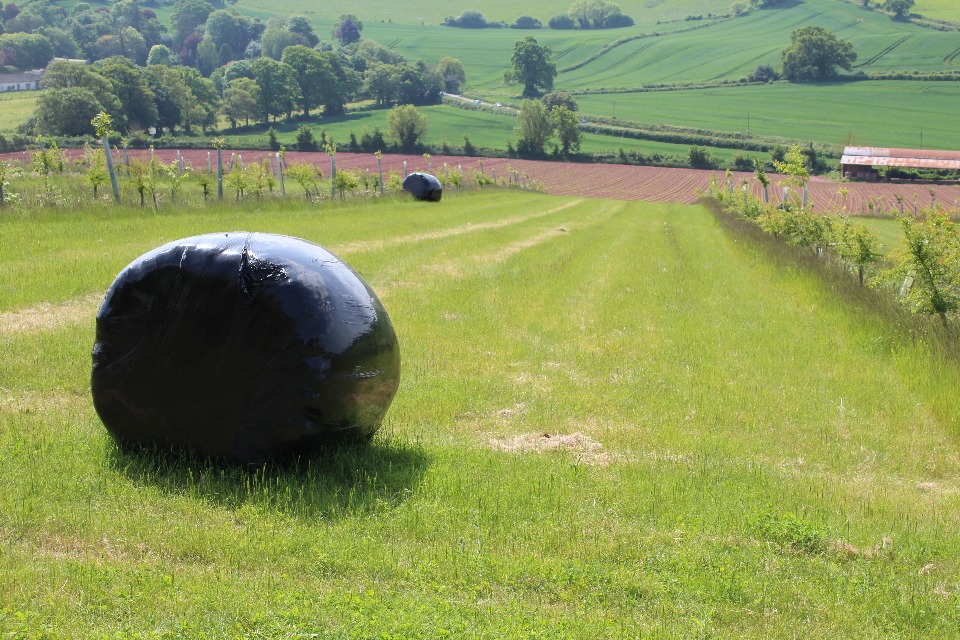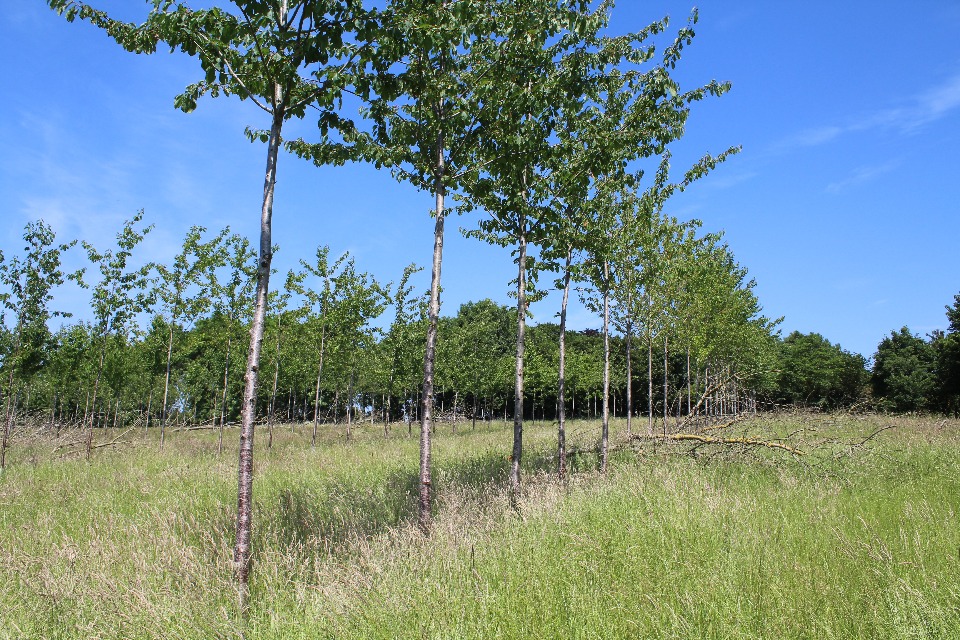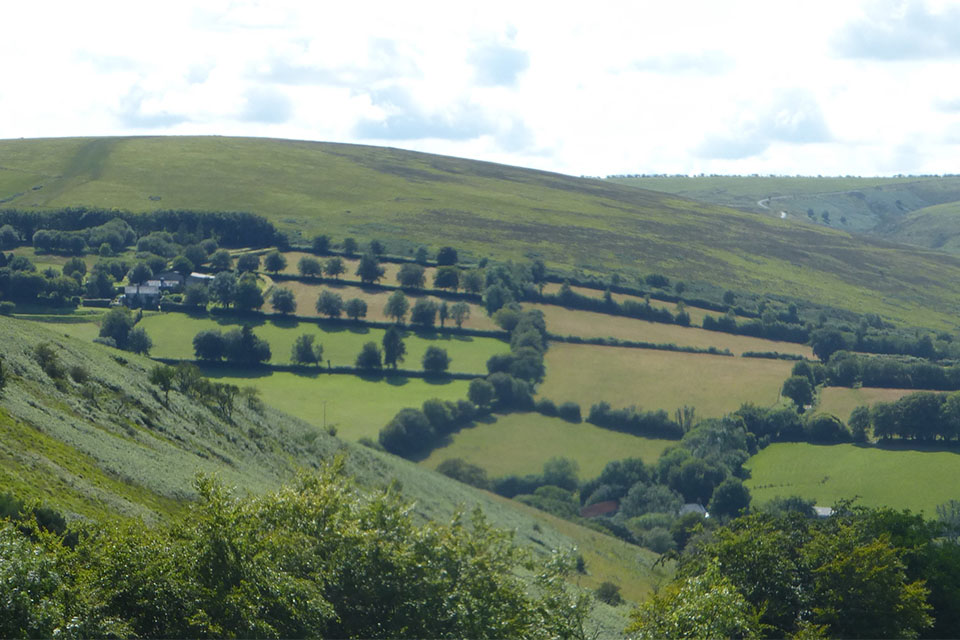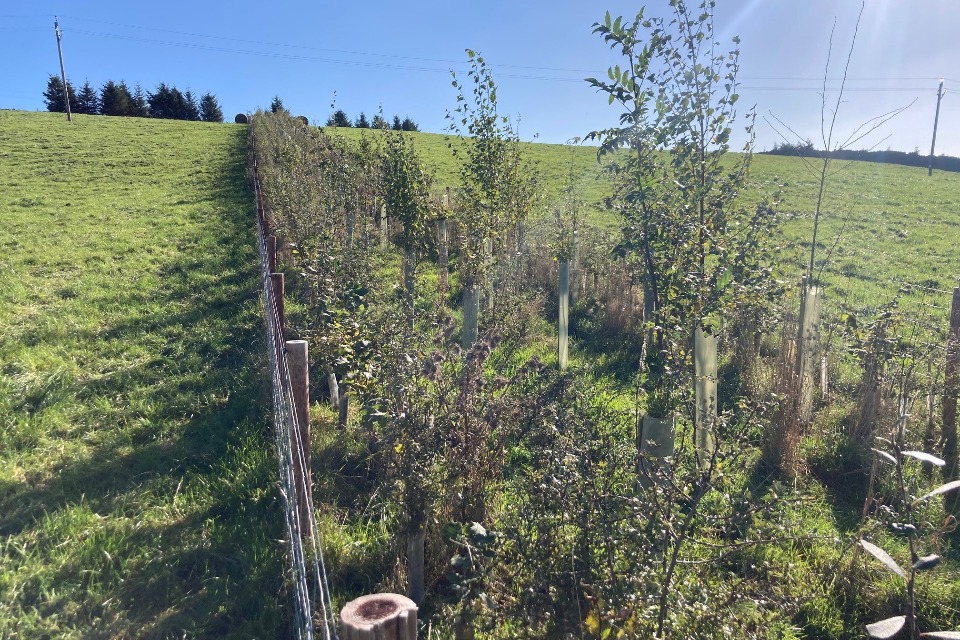Forestry Commission

What is agroforestry?
Agroforestry is the integration of trees into the farming system, while maintaining or enhancing the farms main agricultural output.
Benefits of agroforestry
There are many ways that agroforestry can enhance your farms main production and overall outputs:
- enhanced soil health and protection from extreme weather can increase crop production
- trees can shelter livestock and crops from extreme weather conditions, such as sun, wind and heavy rain
- trees can be managed for additional income streams from wood-based products or fruit and nut produce
Agroforestry also benefits the environment by protecting soil, rivers and biodiversity, capturing and storing carbon, as well as providing cleaner air and water.These benefits can support the long-term resilience of your farm business to climate change.

Agroforestry at Dartington Estate in Devon.
Different types of agroforestry
There are 2 broad categories of agroforestry: in field and around field.
In field agroforestry
Trees are planted in the field to benefit crops and livestock.
The main types of in-field agroforestry are:
- silvoarable agroforestry: trees are planted at wide spacings and are intercropped with arable crops
- silvopastoralagroforestry: trees are combined with forage grassland and livestock production
- wood pasture and traditional orchards: priority habitats managed in a low-intensity way for biodiversity
Planting arrangements

An 18 month old agroforestry site on a Devon farm. Silage has been collected on site.
There is a variety of planting arrangements that can be used for in-field agroforestry, you should decide what works best for your circumstances. For example, silvoarable tree planting arrangements will traditionally use widely spaced rows of trees, but you could use this design in a silvopastoral setting, especially when managing grass for grazing and silage cutting. Common formations include:
-
grids and row formations: trees are arranged formally in grids or rows on arable and grazing land, allowing farmers to maximise traditional farming activity and allow space for machinery. It can also prevent wind affected soil erosion
-
irregular formation: more irregular, or random, tree arrangements are used in grazing systems, especially in upland landscapes and where visual impact might be a consideration

A row of pruned cherry trees.
Management
Pruning and high pruning regularly helps counteract the effects of branch growth. Managing the tree canopy will reduce the competition for light with crops and, grass, and allow easy machinery access.
By removing lower branches, timber quality will be improved by providing a clean, knot-free length of timber.
Around field agroforestry
Trees and woodland provide features around fields to assist with farming practice.
Hedgerow trees
Adding more trees to hedgerows increases tree canopy cover across the farm.
Regular pruning allows more daylight to reach the grass sward or crops. We recommend tree pruning from an early age to avoid negative impacts on farming and machinery access, and increase the potential for better timber.

Tree hedges in Exmoor.
Windbreaks and wider hedges
Trees planted in a linear format, on the edge of a field to reduce wind speed, protect crops and livestock and reduce erosion. Usually, 5 to 10 metre-wide hedges or windbreaks with a core of larger trees, flanked by smaller shrubs. They can have edible plant species for livestock to graze on at the edges, giving them access to additional minerals and nutrients.
Wide hedges, or windbreaks provide practical biosecurity solutions including:
- reducing nose to nose contact for livestock
- useful on farm boundaries

A 5 metre wide hedge with young trees.
Shelterbelts
Similar to windbreaks, shelterbelts are planted in a linear formation on the windward edge of a field to reduce wind speed, but are generally planted in a more extensive manner or in a connected network.
These networks can provide greater shelter across the land and provide effective wildlife corridors for biodiversity.
Riparian buffer
Trees that are planted between agricultural land and watercourses such as streams, rivers and lakes to act as buffers to protect water quality.
Open grown trees (around and in field)
More open tree planting at very low densities, formally or informally arranged. These might be for shade and shelter for livestock, or as boundary or feature markers.
Grants supporting agroforestry
Agroforestry Plan (PA4 capital item) are designed to:
- support you in planning, creating, and the ongoing management of your agroforestry system
- take a holistic view to consider how your agroforestry fits within the context of your landholding and local landscape
- outline how agroforestry supports your business objectives and provides environmental benefits that can boost your farm business resilience
- help you to think about the full range of agroforestry options for your land holding in a holistic way, which can then inform your entry into funding to create and/or manage your agroforestry
- provide a structured approach to gain any permissions you may need to progress your ideas
If youre considering an agroforestry system, you should complete an agroforestry plan. Read more on agroforestry plans on the Countryside Stewardship grant finder tool.
Sustainable Farming Incentive (SFI)
SFI?pays farmers and land managers to take up or maintain sustainable farming and land management practices that:
- protect and benefit the environment
- support food production
- improve farm productivity
Under SFI, you can apply for funding to support establishing woodland trees and fruit trees in an in-field agroforestry system, as well as a species diversity supplement for planting 5 or more species.?
Read more about all capital items to support agroforestry on the Countryside Stewardship grant finder tool.
There are also 2 annual revenue payments available under SFI, you can find these in the find funding for land or farms tool.
England Woodland Creation Offer (EWCO)
EWCOis a government grant scheme, managed by the Forestry Commission.EWCOsupports a range of woodland creation types including riparian buffer and shelterbelts.
Countryside Stewardship
Countryside Stewardshipoffersfunding to farmers and land managers to protect and enhance the natural environment.
More information on Countryside Stewardship Higher Tier and Defras broader approach to environmental land management will be confirmed in due course.
Regional funding support
Depending on your location, you can apply for a tree p
